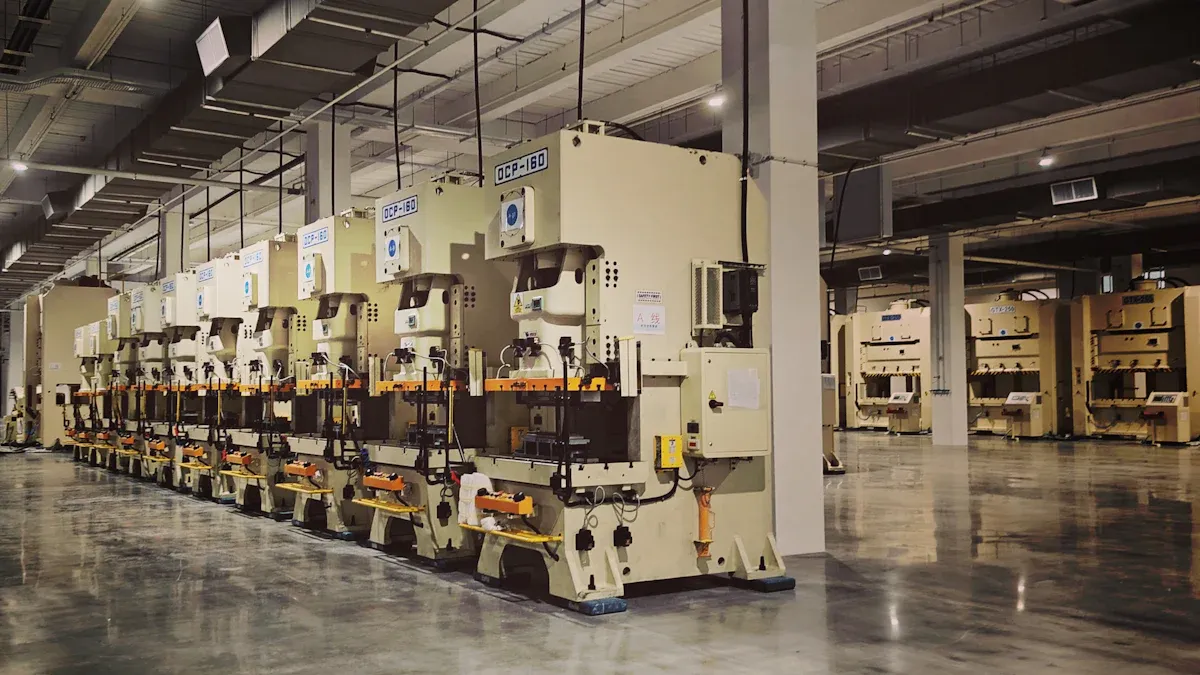China and Vietnam: Differences in Manufacturing Supply Chains

The comparison between China and Vietnam for manufacturing supply chains has become increasingly important in recent years. Several factors drive this trend:
Labor costs in Vietnam average $2.99 per hour, significantly lower than China's $6.50 per hour.
Vietnam's industrial production has grown by 6.3%, while China still leads with 28.7% of global manufacturing output.
The US-China trade war has prompted many companies to explore Vietnam as an alternative manufacturing hub.
You must also consider differences in infrastructure, logistics, and material sourcing. While China's mature systems support high-volume production, Vietnam's emerging capabilities and free trade agreements with 56 economies make it a strong contender. With JUSDA's expertise, businesses can navigate these complexities and make informed decisions.
Key Takeaways
Vietnam has deals with 56 countries to lower taxes on exports. These deals make it easier for businesses to sell goods worldwide.
China is great at making high-tech products because workers are skilled. Its advanced systems make it the best choice for precise industries.
JUSDA helps businesses manage shipping and supply chains in both places. Their knowledge makes work easier and more efficient.
China's Manufacturing Strengths

Established Infrastructure and Ecosystem
China's manufacturing ecosystem stands as a global benchmark for efficiency and scale. The country produces 50-60% of the world’s crude steel and primary aluminum, showcasing its dominance in raw material production. This robust infrastructure supports high-volume manufacturing across diverse industries. Additionally, the operation of China's high-speed railway (HSR) has significantly enhanced manufacturing capabilities. HSR connectivity reduces financing costs and fosters technological innovation, particularly benefiting larger and state-owned firms. These advancements make China a leader in industrial efficiency and innovation.
Energy efficiency also plays a critical role in China's manufacturing success. From 2000 to 2015, energy intensity in steel production decreased by approximately 30%. This improvement aligns with the country's broader goals, such as the 'Made in China 2025' initiative and the 2030 carbon-neutral target. These policies not only enhance sustainability but also strengthen the manufacturing ecosystem, ensuring long-term competitiveness.
Skilled and Experienced Workforce
China's workforce is a cornerstone of its manufacturing prowess. Workers in this sector possess a wide range of hard skills, with blue-collar roles requiring an average of 55 skills. Technicians and professionals demonstrate even greater expertise, needing up to 71 skills on average. This skill diversity ensures that manufacturing processes remain efficient and adaptable to technological advancements.
The workforce's experience further amplifies its value. Many workers have honed their skills over decades, contributing to China's reputation for high-quality production. This depth of expertise allows businesses to scale operations without compromising on quality, a critical factor when comparing China and Vietnam as manufacturing hubs.
Scale and Production Capacity
China's production capacity is unmatched on a global scale. For instance, the country leads in electric vehicle (EV) production, manufacturing 9.58 million units last year alone. It also exported 1.2 million EVs, reinforcing its position as a global leader in this rapidly growing market. With global EV sales expected to rise sixfold by 2030, China's ability to meet demand highlights its unparalleled scale and efficiency.
This capacity extends beyond EVs. China's manufacturing sector consistently delivers high-volume outputs across industries, from electronics to heavy machinery. This scalability ensures that businesses can meet global demand efficiently, making China a preferred choice for large-scale production.
Technological Advancements in Manufacturing
China's manufacturing sector has embraced cutting-edge technologies to maintain its global leadership. You can see this in the widespread adoption of automation, robotics, and artificial intelligence (AI) across industries. These advancements streamline production processes, reduce errors, and improve overall efficiency. For example, factories now use AI-powered systems to monitor quality in real time, ensuring consistent product standards. This level of precision gives businesses a competitive edge in global markets.
Private and foreign-owned firms play a significant role in driving innovation. Recent studies highlight that foreign-owned companies set benchmarks for technical efficiency, while private firms lead in advancing new technologies. State-owned enterprises have also undergone revitalization, showcasing China's commitment to strengthening its manufacturing capabilities. This multi-faceted approach ensures that every sector contributes to technological progress.
China's technological advancements extend beyond factories. The country invests heavily in research and development (R&D), ensuring continuous innovation. With these efforts, China remains a global leader in manufacturing technology, offering you unparalleled opportunities to scale and innovate.
Vietnam's Emerging Manufacturing Capabilities

Cost-Effectiveness and Competitive Labor Costs
Vietnam offers a cost-effective manufacturing environment, making it an attractive choice for businesses. Labor costs in Vietnam are significantly lower compared to other countries in the region. For instance, the monthly minimum operating cost in Vietnam is $79,280, which is highly competitive when compared to neighboring countries like Singapore and Thailand.
Country | Monthly Minimum Operating Cost | Labor Cost Advantage |
|---|---|---|
Vietnam | $79,280 | Substantial labor pool |
Singapore | Higher than Vietnam | N/A |
Thailand | Competitive | Reasonably priced |
Philippines | Competitive | Reasonably priced |
This affordability, combined with a substantial labor pool, allows you to optimize production costs without compromising quality. Vietnam's competitive edge in labor costs positions it as a strong contender when comparing China and Vietnam for manufacturing supply chains.
Growing Workforce and Demographics
Vietnam's workforce is growing steadily, offering a mix of affordability and skill. The country has a labor force of 52.4 million people, with 27.8% holding degrees or certificates. This skilled labor pool ensures that industries can access the expertise needed for specialized manufacturing. The unemployment rate for the working-age population is just 2.24%, reflecting a robust labor market. However, the youth unemployment rate of 7.99% highlights a large pool of potential workers ready to enter the workforce.
Average monthly income has risen to 7.6 million VND, keeping labor costs competitive.
Vietnam's stable economic growth and low inflation rates create a favorable environment for business investment.
Increasing foreign direct investment (FDI) underscores the country's growing appeal as a manufacturing hub.
These factors make Vietnam an ideal location for businesses seeking a balance between cost and workforce quality.
Trade Agreements and Global Market Access
Vietnam's strategic trade agreements provide unparalleled access to global markets. The country has signed free trade agreements (FTAs) with 56 economies, including major markets like the European Union and Japan. These agreements reduce tariffs and simplify trade processes, enabling you to export goods more efficiently.
Vietnam's industrial parks further enhance its global competitiveness. These parks focus on technological readiness and digital solutions, improving production efficiency. Additionally, Vietnam leads the world in high-tech imports and exports, showcasing its ability to integrate into the global value chain. Its strategic location in Southeast Asia also facilitates easy access to key markets, making it a vital player in international trade.
Tip: Leveraging Vietnam's trade agreements can help you reduce costs and expand your market reach.
By capitalizing on these advantages, you can position your business for success in the global manufacturing landscape.
Industry Specialization: Textiles, Electronics, and More
Vietnam has emerged as a key player in specialized industries like textiles and electronics. These sectors benefit from the country's strategic location, skilled workforce, and favorable trade policies. Southern Vietnam, for example, dominates the textile market with over 43.2% of the market share. Ho Chi Minh City serves as a commercial hub, supported by advanced infrastructure such as deep-sea ports. Provinces like Binh Duong and Dong Nai attract significant foreign investments due to their established supply chains and business-friendly policies.
The electronics sector also plays a vital role in Vietnam's economy. In March 2020, imports of computers and electronic components from Japan reached USD 398.3 million, accounting for 7.9% of total turnover. Imports from Malaysia contributed USD 131.6 million, representing 2.6% of the total. These figures highlight Vietnam's growing integration into global electronics supply chains. The country’s focus on high-tech manufacturing has made it a preferred destination for companies seeking cost-effective production.
Vietnam’s trade agreements further enhance its competitiveness. With 16 operational Free Trade Agreements (FTAs), the country enjoys reduced tariffs and streamlined trade processes. This access to major markets like the EU and the US positions Vietnam as a global manufacturing hub. By 2025, Vietnam aims to increase exports by 12%, with a forecasted export surplus of USD 24.7 billion for 2024.
Note: Vietnam’s specialization in textiles and electronics offers you opportunities to tap into established supply chains and advanced infrastructure. These advantages make it an ideal location for businesses looking to expand globally.
JUSDA Vietnam: Supporting Vietnam's Manufacturing Growth
JUSDA Vietnam plays a pivotal role in strengthening the country’s manufacturing ecosystem. With over 15 years of experience, JUSDA Vietnam offers comprehensive logistics solutions tailored to meet diverse industry needs. The company specializes in air freight, sea freight, and trucking services, along with the Vietnam-China-Europe Railway Express for efficient land transport. Its self-owned customs team ensures smooth clearance processes, reducing delays and enhancing efficiency.
JUSDA Vietnam’s warehousing capabilities further support manufacturing growth. The company operates seven warehouses spanning 110,000 square meters, equipped with advanced inventory management systems like eVMI and Juslink. These systems provide real-time stock tracking, helping you optimize supply chain operations. Value-added services such as picking, packing, labeling, and clean room sorting cater to specialized industries like electronics and semiconductors.
Tip: Partnering with JUSDA Vietnam allows you to leverage its expertise in logistics and supply chain management. This partnership ensures seamless operations, enabling you to focus on scaling your business.
JUSDA Vietnam’s commitment to operational excellence and compliance with stringent standards makes it a trusted partner for businesses. Its strong relationships with customs authorities and multilingual capabilities in Chinese, English, and Vietnamese further enhance its reliability. By choosing JUSDA Vietnam, you gain access to a robust logistics network that supports your manufacturing goals.

JUSDA Solutions
To provide you with professional solutions and quotations.
Key Comparisons Between China and Vietnam
Labor Costs and Workforce Availability
When comparing labor costs, Vietnam offers a clear advantage. The average monthly wage in Vietnam's manufacturing sector ranges from $200 to $300, significantly lower than China's $500 to $800. This difference allows you to save 30–50% on labor expenses by choosing Vietnam. Additionally, Vietnam's minimum wage is between $175 and $250, while China's ranges from $300 to $500. These lower costs make Vietnam an attractive option for businesses seeking cost-effective manufacturing solutions.
Factor | China | Vietnam |
|---|---|---|
Average Monthly Wage (Manufacturing) | $500 - $800 | $200 - $300 |
Minimum Wage (Monthly) | $300 - $500 | $175 - $250 |
Productivity Rate (%) | 85 | 90 |
Infrastructure and Logistics
China's infrastructure is one of its greatest strengths. The country boasts an extensive network of high-speed railways, highways, and ports, enabling efficient transportation of goods. For example, China's high-speed railway system has revolutionized logistics, reducing delivery times and costs. This advanced infrastructure supports high-volume production and ensures timely delivery to global markets.
Trade Policies and Tariffs
Vietnam's trade policies are more favorable compared to China's. The country has signed free trade agreements (FTAs) with 56 economies, including the Comprehensive and Progressive Agreement for Trans-Pacific Partnership (CPTPP) and the EU-Vietnam Free Trade Agreement (EVFTA). These agreements reduce tariffs and simplify trade processes, making Vietnam an attractive option for sourcing. For instance, Vietnam faces a 46% tariff on U.S. imports, compared to China's 104%. This significant difference can help you reduce costs and improve profitability.
China, on the other hand, has higher tariff levels and fewer recent trade agreements. However, its mature manufacturing ecosystem and global market dominance still make it a preferred choice for many industries. If your business relies heavily on international trade, Vietnam's expanding trade agreements and lower tariffs provide a competitive edge.
Tip: Leverage Vietnam's trade agreements to reduce costs and expand your market reach. For industries requiring high-volume production, China's established systems may still be the better option.
Quality Standards and Product Specialization
When comparing manufacturing in China and Vietnam, you must consider the quality standards and product specialization of each country. These factors directly impact the reliability and marketability of your products.
China has built a reputation for maintaining high-quality standards across various industries. The country enforces strict quality control measures, especially in sectors like electronics, automotive, and heavy machinery. Many factories in China adhere to international certifications such as ISO 9001 and ISO/TS 16949, ensuring that products meet global benchmarks. For example, if you manufacture electronic components, Chinese suppliers often provide advanced testing facilities to guarantee precision and durability.
Vietnam, on the other hand, is still developing its quality assurance systems. However, the country has made significant progress in recent years. Industries like textiles and footwear excel in meeting international standards, thanks to Vietnam's focus on craftsmanship and attention to detail. If your business operates in these sectors, Vietnam offers a competitive edge. Additionally, the electronics industry in Vietnam is rapidly improving its quality standards, driven by foreign investments and technology transfers.
Product specialization also plays a key role in your decision-making. China excels in producing high-tech goods, including semiconductors, electric vehicles, and robotics. The country's advanced infrastructure and skilled workforce enable it to handle complex manufacturing processes. Vietnam specializes in labor-intensive industries such as textiles, furniture, and basic electronics. While Vietnam may not match China's technological capabilities, it offers cost-effective solutions for simpler products.
Tip: If your business requires high-tech manufacturing or stringent quality control, China is the better choice. For cost-effective production in labor-intensive industries, Vietnam provides excellent opportunities.
Implications for Businesses
Choosing Based on Cost and Scale
When deciding between China and Vietnam for manufacturing, cost and scale are critical factors. Vietnam offers lower labor costs, with an average minimum monthly wage of $192.55 compared to China's $392.01. This cost advantage allows you to allocate resources more efficiently, especially for labor-intensive industries. However, China's larger workforce of 772.2 million people provides unmatched production capacity, making it ideal for high-volume manufacturing.
Vietnam's reliance on imported raw materials, such as the 70-80% of fabrics sourced from China, can impact overall costs and logistics. On the other hand, China's mature supply chain ecosystem ensures seamless access to raw materials and components. If your business prioritizes cost savings, Vietnam presents a compelling option. For large-scale operations requiring established infrastructure, China remains the better choice.
Tip: Evaluate your production needs carefully. Vietnam excels in cost-effectiveness, while China offers scalability and supply chain reliability.
Industry-Specific Considerations
Your industry plays a significant role in determining the best manufacturing location. China leads in high-tech industries like electronics, machinery, and electric vehicles. Its advanced infrastructure and skilled workforce support complex manufacturing processes. For example, China exported 1.2 million electric vehicles last year, showcasing its dominance in this sector.
Vietnam specializes in textiles, footwear, and basic electronics. Southern Vietnam, with its established textile supply chains, is a hub for garment production. The electronics sector is also growing rapidly, driven by foreign investments and technology transfers. If your business operates in these industries, Vietnam offers a competitive edge.
Note: Choose China for high-tech manufacturing and Vietnam for labor-intensive industries. Align your decision with your industry requirements.
Long-Term Supply Chain Strategies
Developing a long-term supply chain strategy requires balancing risks and opportunities. Vietnam's free trade agreements with 56 economies enhance market access and reduce tariffs, making it an attractive option for global expansion. Government support, including tax incentives and infrastructure development, further strengthens Vietnam's appeal.
China, despite rising labor costs, remains a leader in supply chain resilience. The country’s exports grew by 9.9% to $239.7 billion in September 2020, reflecting its ability to adapt to global challenges. Additionally, 93% of companies in China plan to transform their supply chain systems, focusing on technology integration and risk management.
Key trends shaping long-term strategies include:
Risk Management and Resilience: Identify and mitigate risks to ensure operational continuity.
Technology Integration: Use AI and IoT to enhance efficiency and transparency.
Sustainability: Adopt eco-friendly practices to meet consumer demand for responsible business.
Tip: Incorporate digital transformation and sustainability into your supply chain strategy. Both China and Vietnam offer unique opportunities to align with these trends.
Balancing Risks and Opportunities with JUSDA's Expertise
Navigating the complexities of manufacturing in China and Vietnam requires a strategic approach. Each country offers unique advantages, but they also come with risks that can impact your supply chain. This is where JUSDA's expertise becomes invaluable. By leveraging JUSDA's comprehensive solutions, you can balance these risks and opportunities effectively.
Identifying and Mitigating Risks
JUSDA helps you identify potential risks in your supply chain. These risks may include:
Regulatory Challenges: Differences in customs policies and trade regulations can delay shipments.
Logistics Disruptions: Cross-border transportation delays can affect delivery timelines.
Supply Chain Complexity: Managing multiple suppliers across regions can lead to inefficiencies.
JUSDA's Supply Chain Management Collaboration Platform addresses these challenges. It provides real-time tracking, demand forecasting, and customs coordination. For example, the platform's transport coordination feature allows you to monitor shipments in real time. This reduces delays and ensures timely delivery.
Tip: Use JUSDA's advanced tools to gain visibility into your supply chain. This helps you anticipate issues and take proactive measures.
Leveraging Opportunities for Growth
Both China and Vietnam offer opportunities for growth. China excels in high-tech manufacturing, while Vietnam provides cost-effective solutions for labor-intensive industries. JUSDA's expertise ensures that you can capitalize on these opportunities.
In China: JUSDA's JusLink Intelligent Supply Chain integrates IoT and big data. This enhances efficiency and supports large-scale production.
In Vietnam: JUSDA Vietnam specializes in logistics for electronics, textiles, and semiconductors. Its multilingual team ensures smooth communication and operations.
By partnering with JUSDA, you can align your supply chain strategy with your business goals. Whether you prioritize cost savings or technological innovation, JUSDA provides tailored solutions to meet your needs.
Why Choose JUSDA?
JUSDA's global network and industry expertise make it a trusted partner for businesses. With over 155 service points worldwide, JUSDA offers seamless logistics solutions. Its advanced technologies, such as cloud warehousing and AI-driven platforms, provide you with a competitive edge.
JUSDA Vietnam further strengthens this value proposition. Its extensive warehousing capabilities and value-added services cater to diverse industries. Whether you need clean room sorting or equipment relocation, JUSDA Vietnam delivers reliable solutions.
Callout: Partnering with JUSDA ensures that your supply chain remains efficient, cost-effective, and adaptable to changing market conditions.
By choosing JUSDA, you gain access to a comprehensive suite of services designed to optimize your supply chain. This allows you to focus on scaling your business while minimizing risks.
When comparing China and Vietnam, each offers unique strengths for manufacturing.
China: A robust infrastructure, skilled workforce, and advanced quality control systems.
Vietnam: Cost-effective labor, political stability, and favorable trade agreements.
Aspect | Vietnam | China |
|---|---|---|
Advantages | Rapid growth, cost-effective labor, favorable trade agreements | Established infrastructure, skilled workforce |
Challenges | Developing supply chains, quality control issues | Complex supply chains, rising costs |
JUSDA and JUSDA Vietnam simplify these complexities. Their expertise ensures efficient logistics, tailored solutions, and seamless operations, empowering you to make strategic decisions confidently.
FAQ
Can JUSDA help you manage supply chain complexities in both countries?
Yes, JUSDA provides tailored solutions for China and Vietnam. Its advanced platforms offer real-time tracking, demand forecasting, and customs coordination. JUSDA Vietnam specializes in logistics for electronics, textiles, and semiconductors, ensuring seamless operations.
Which country is better for labor-intensive industries?
Vietnam is better for labor-intensive industries like textiles and footwear due to its lower labor costs and growing workforce. China, with its skilled labor and advanced infrastructure, suits industries requiring high-tech manufacturing and precision.
How can you ensure supply chain resilience in either country?
Partner with JUSDA to build a robust supply chain. Use its JusLink platform for real-time insights and inventory optimization. JUSDA Vietnam’s strong customs relationships and advanced warehousing ensure smooth operations, even during disruptions.
Note: A resilient supply chain minimizes risks and ensures long-term success.
See Also
Enhancing Supply Chain Strategies in Advanced Manufacturing
Transforming Supply Chains Through Innovative Robotics Technology
The Importance of Supply Chains in Global Trade
Boosting Supply Chain Performance With AI Innovations
Achieving Success in High-Tech Manufacturing Through Lean Logistics
